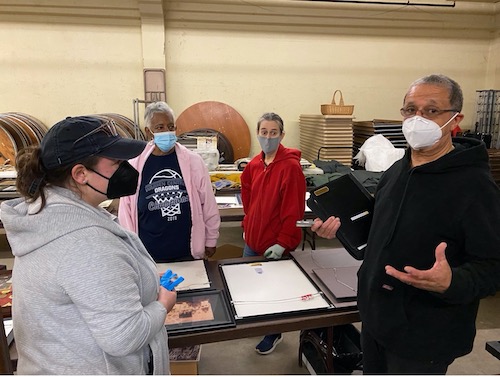WKU News
African American Museum rebuilds after tornado, fire damage
- Jessica Luna
- Tuesday, January 18th, 2022

From left: WKU Folk Studies graduate student Landyn Hatch, African American Museum Project Manager Wathetta Buford, Kentucky Museum Assistant Mary Lynn Claycomb, and African American Museum Board Chairman Dr. John Hardin discuss the African American Museum's disaster recovery plan.
On the morning of Saturday, December 11, 2021, Bowling Green’s African American Museum suffered damage from the deadly tornadoes that swept the state. As a result, the building received some wind and tree damage, but the worst challenges would lay in the weeks ahead.
During the evening hours of Wednesday, December 22, an electrical fire broke out at the African American Museum, stemming from the existing tornado damage. Firefighters quickly responded to the fire and brought many items to the Service and Supply Building on WKU’s campus. Over the next several days, the recovery team, consisting of WKU Department of Environmental Health and Safety’s Dr. David Oliver and his team, the African American Museum’s Board Chairman Dr. John Hardin, Kentucky Museum Director Brent Björkman and his team, Mary Lynn Claycomb, Tiffany Isselhardt, and Sandy Staebell, along with WKU Department of Folk Studies’ Dr. Ann Ferrell and Landyn Hatch, and WKU Library Public and Technical Services' Joe Shankweiler, sprang into implementing the museum’s disaster plan.
Drying tables were immediately set up in the WKU Service and Supply Building. Members of the team assessed items and boxed them up to be sent to the lab at the Kentucky Museum. Leah Craig, Registrar at the National Corvette Museum, also provided her expertise during the recovery process and offered her museum’s walk-in freezer to be used by the team for storage of damaged artifacts and documents the group deemed most critically in need of care.
As of this week, most recovered items are fully dried and are being temporarily housed at the Kentucky Museum. The team is working with WKU’s Department of Facilities Management as well as insurance liaisons and conservation specialists to determine their next steps.
“Everyone has been working together to preserve every recoverable artifact from the museum,” said Brent Björkman, Director of the Kentucky Museum and the Kentucky Folklife Program. “It is going to be a long road, but we are focusing on salvaging the legacy of African American community life in Bowling Green. The museum hopes to reopen and we are continuing to support their hopes and desires for the future as the process continues forward.”
One of the members of the team, Landyn Hatch, is a Folk Studies graduate student in the Department of Folk Studies and Anthropology in WKU’s Potter College of Arts & Letters. Hatch completed an internship with the African American Museum last summer and lends her vast knowledge of the museum to assist in the recovery efforts. She will be continuing her work with them as part of her capstone project this spring semester.
“We are especially grateful for the work of Landyn Hatch,” said Tiffany Isselhardt, Development and Marketing Manager for the Kentucky Museum. “She volunteered her winter break time to help organize the collection.”
While the museum does not know when it will be able to reopen, the museum has applied to FEMA and the Foundation for Advancement in Conservation for funding. The museum also has a GoFundMe to help offset the increasing costs from the recovery effort. If you would like to donate to the African American Museum’s relief fund, visit https://www.gofundme.com/f/tornado-relief-aframermuseum?utm_campaign=p_cp+share-sheet&utm_medium=copy_link_all&utm_source=customer.
For information about the African American Museum, contact Dr. John Hardin, WKU History Professor Emeritus and Board Chairman of the African American Museum, at jhnhardin@gmail.com.
Contact: Jessica Luna, (270) 745-3259 or jessica.luna@wku.edu

